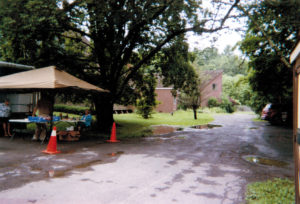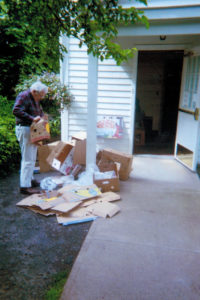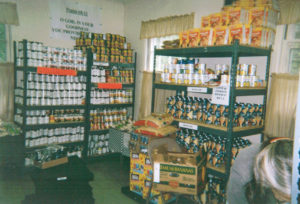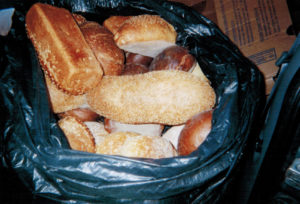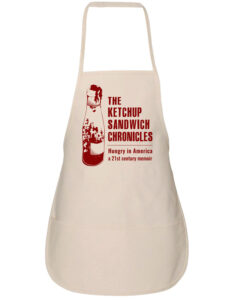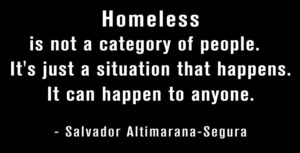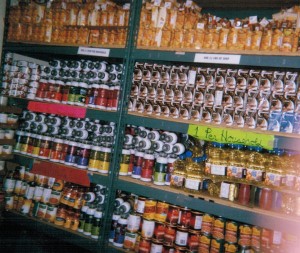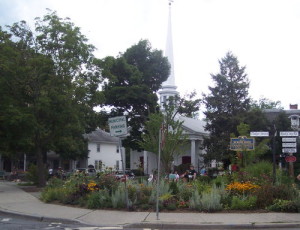A Prayer to the Most Powerful Woman in the World
Somehow, when I’m in a food pantry, I feel the presence of Mother Mary. She greets us and invites us to know her better. She is also ready to sit with us on our spiritual and physical journeys.
People go to Mary with issues related to children and with healing of all kinds. They go to Mary for forgiveness, compassion, and mercy. That puts her square in the middle of the food pantry line.
Mary has no doctrine. Nor does she have a dogma. Mary’s story shows us she knows intimately about hunger, suffering, sorrow, and death.
Mary’s prayers count.
Mary waits for us to reach out to her. Mary has been waiting for us long before we became aware of her.
Mary accepts us, whatever our beliefs. She doesn’t care whether we follow an established religion or even no religion. She accepts us as we come to her. Mary belongs to all faiths, all religions, all paths, and all people.
She protects, heals, and guides us all. She is there with us in the pantry line. She offers comfort in troubled times. Mary teaches that we all have value.
Sensing her presence, I feel she is showing us how to turn our pain into life lessons to help us cope with and enjoy life.
If we listen, Mary protects us when danger lies ahead.
I write these things because I somehow know that they are real. I know this to my bones. I’m not sure how this knowing came about. And, truthfully, I quit asking HOW a long time ago.
Working in a food pantry brought up questions that were dormant throughout my life. I pondered, worried, and searched for answers for years. I’ve finally decided that there are some things I don’t have the answers for yet.
And, so what. Do I have to know the answers to everything? After all, I’m only human. And, an old human at that.
All I can do is say “thank you” to Mary for being here for us.
Thank you Mary for holding me up in the food pantry when the numbers were too high and getting higher every week.
Thank you for being there with us all in that line.
Amen.
Thanks for reading this article. I am not here to challenge or change your beliefs about feeding the hungry or about any other thing, as far as that goes. I am not here to change your story. Instead, I am here as a conduit for your own healing.
Please share this article with friends and relatives. Forward this post to your preferred social media network.
Check out my books on www.thurmangreco.com. The website is being repaired. To purchase a book or 2, please contact me at thurmangreco@gmail.com.
Let’s Live with Thurman Greco is a program aired weekly on Woodstock’s own educational TV channel 23. This show is an informative, upbeat hour with no rehearsals. Some segments support the blog information and highlight Reiki Therapy, Hand and Food Reflexology, and other wellness subjets.
Guests are various people whose lives have brought them to Woodstock for a day, a week, an hour, a decade or more. I can truthfully boast that guests report they enjoy the experience.
Let’s Live has been running for over 15 years with an occasional intermission, now and then.
Enjoy interesting and fun programs while getting a peek into Woodstockers being themselves. Search “Let’s Live with Thurman Greco” on YouTube and check out the ever growing list of videos.
Finally: THIS BLOG IS CELEBRATING ITS 10TH YEAR!!!!!!!!!!!!!!!!!!!!!!!!
Healing 1: Serving the Hungry with an Understanding Heart
“You, God, are my God, earnestly I seek you; I thirst for you, my whole being longs for you, in a dry and parched land where there is no water.” – Psalm 63:1
“That person lives in Shandaken. He shouldn’t even be here.”
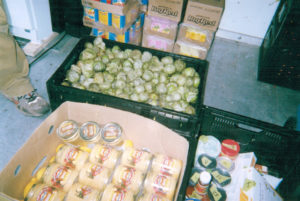
The pantry served shoppers, volunteers, hungry people. Volunteers fed everyone in the line. No exceptions.
Distributing groceries brought forgiveness and healing. Healing was an after thought of forgiveness.
For me, healing required some commitment and thought. Whether or not this was true, questions always arose:
“Am I ready to be healthy?”
“Can I get well if it’s scary?”
“Can I leave the old me aside if it’s necessary for healing?”
“Why am I going through this?”
“What is the meaning of it all?”
These questions could be painful. Healing can be hard on everyone.
The pantry line had massage therapists, Reiki practitioners, medical intuitives, and other healers.
As a healer, I know healing happens on several levels in our lives: physical, mental, spiritual, emotional, mythical. Both healing and getting well were special challenges because many of the people in the hallway, the pantry room, and out in the parking lot didn’t have health care.
While he had his office, Woodstock had Dr. Longmore. After his office closed, things were tough for many. As health care became scarce, everyone became personally involved with the differences between healing and getting well. For some, this was part of the spiritual journey.
Hunger often went beyond a plate of beans or a jar of peanut butter. That’s why food is essential to healing. That’s where homemade soup comes in.
Sharing food in the pantry helped people heal. Fresh vegetables, eggs, and Bread Alone bread offered a healing experience with abundance. As we fed the shoppers, we helped ourselves and each other.
In some cases, the shoppers became the volunteers or the volunteers joined the shoppers. Shoppers came to get food and found they could volunteer. Volunteering changed them. As a person distributed groceries, the volunteer made contact with another person and was able to smile.
Pantry experiences coaxed us out of our own problems. Offering a sense of community gives back so much more.
Do you want to be healed? Healing and feeding are connected.
Sooner or later, we all get sick. Finally, we die.
No one escapes. This truth is harder on hungry people who have no $$$ for health care.
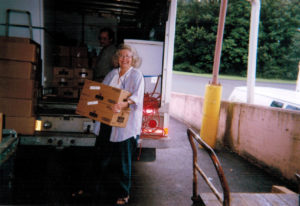
Hungry people are often blamed for their inability to deal with the situation. It’s as if it’s their fault for being down and out in Woodstock. If they lived right, they would be healthier, make more $$$ in their jobs.
If critics stopped and thought about how insufficient nutritious food, improper housing, and inadequate or nonexistent healthcare impacts a person, they might feel differently.
What did it matter that there were no jobs in the area and none of those that came open paid over $8.00 an hour?
Because they were down and out, they must be guilty of something.
They were negative thinkers, lacking faith, and basically lazy. Something.
They were gay, trans, promiscuous, alcoholics. Something.
They were freeloaders, irresponsible, flaky. Something.
Healing and getting well are two different things, acting in different ways. But, whether a person heals, gets well, or both, change happens.
“Do I want to heal?”
“Do I want to be well?”
“What if I come out of this experienced a different person?”
“What if it takes a long time?”
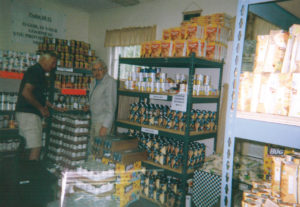
In the midst of this, the pantry offered some normalcy to the shattered lives of hungry people when they took pantry food home to wherever and whatever that was, fixed a meal, and served it to those in the household.
It was supper from the pantry.
Health issues pointed to the spiritual challenges which popped up on the path to the pantry. Healing was on the agenda. We all wanted to get well.
People getting well overcome symptoms. Getting well means doctor’s visits, therapy, pills, creams. These things were simply not an option for pantry shoppers because there was no money.
Symbolic healing occurred in the hallway on pantry days as shoppers and volunteers discussed their diabetes, PTSD, cancer, allergies.
Working and shopping in the pantry was therapy to volunteers and shoppers. These hallway conversations were cheaper than the physical and mental health services they had no money for anyway.
These conversations were essential because talking about a health issue promotes healing. Shared symptoms gave us all support, strength, validity.
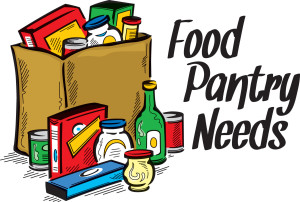
Everyone walking through the door to the pantry, whether a shopper or volunteer, was asked to leave the past behind. This experience was different for everyone. But, think about it, how can we move forward into our new lives if we never give anything up.
For some, giving up the past means letting go of things lost: the job, the home, maybe the family, self-esteem, the car, good health, money, insurance, the pet, anger, or drugs.
As the past disappears, the remaining spiritual baggage weighs less and less. Prejudices become fewer. Fears diminish. We heal!
Some things surrendered were physical, some mental, and some emotional. But, one thing is certain, whatever the category, the experiences all had a spiritual aspect.
Giving and receiving food brought everyone a little peace.
Everyone coming to the pantry heals somehow. The pantry community supports and approves hungry individuals as they climb back on the road to wellness and something offering normalcy.
Nobody just wakes up one day and says “I think I’ll go down to the local food pantry and volunteer.” People spending time in pantries all travel down the path. Healing has signposts along the way.
Some needed physical healing. Volunteers occasionally came to the pantry so ill that they were barely able to make it into the building. When this happened, I stationed them at the Items of Dignity table distributing toilet paper, shampoo, razors. They offered one roll of toilet paper and one other item to each shopper.
 Each week, Deanna slowly walked the two blocks to the pantry and then worked in the hallway a couple of hours while she gathered enough energy to return home.
Each week, Deanna slowly walked the two blocks to the pantry and then worked in the hallway a couple of hours while she gathered enough energy to return home.
“Don’t forget your roll of toilet paper, Judith. We’ve got some hand cream today. Can you use that or would you prefer tooth paste?”
When Deanna finally couldn’t work in the hallway anymore, Rachel gracefully sat at the Items of Dignity table helping shoppers choose their two items. Rachel lived in nearby Mt. Tremper. Her living situation seemed somewhat precarious because every few months she looked for a new place to live. She lived in her car a couple of times.
Thank you for reading this blog post. This is the first food pantry article on healing.
Please forward this article with your preferred social media network. Share it with a friend.
If you are interested in healing, please check out my other blog: www.reflexologyforthespirit.com.
Thanks again.
Thurman Greco
Woodstock, NY
PS: Many programs are now uploaded to YouTube. More are being added weekly. Enjoy!
![]()
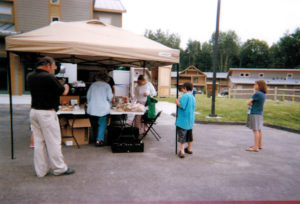

Seniors and Those Who Care for Them
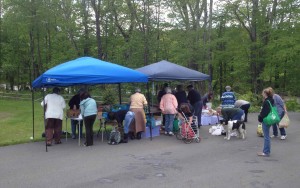 What does this photo have to do with hungry seniors and those who care for them? A lot, actually. This photo is a group of seniors getting food from the Reservoir Food Pantry in Boiceville, New York.
What does this photo have to do with hungry seniors and those who care for them? A lot, actually. This photo is a group of seniors getting food from the Reservoir Food Pantry in Boiceville, New York.
Carolina Gerard, an outreach intern from the National Council for Aging Care forwarded an article to me this week. It addresses some of the causes, complications, and cures for senior food insecurity. Can you take a moment to go to http://www.aginginplace.org/the-facts-behind-senior-hunger
I’m sure you will find it interesting and engaging.
Thanks again for reading this article. Please share it with your favorite social media network.

My Story and the 9 Truths I Discovered
I began my life changing journey fighting hunger on a cool autumn Thursday in Woodstock, New York in 2005 where I volunteered for the first time at the local food pantry.
I was assigned a shift with Marie Duane. I drove over to the Woodstock Reformed Church, parked my car behind the buildling and cautiously walked in. I had never been to the pantry before.
I entered the empty hallway and found the pantry on the right. I walked into the room and there it was: a small space, actually, about 12′ by 16′. Each wall supported a set of metal shelving units. Each unit stood about 6′ high and 3′ deep with 4 shelves. Most of the shelves were empty. A few shelves had some food:
cereal
tuna
soup
peanut butter.
There was a little handwritten note in front of each display:
person: 1 item, family: 1 item.
There may have been other items on shelves but I don’t remember them.
A small table stood in the center of the room. A metal folding chair was placed in front of each window.
We sat in the chairs, Marie and I, and chatted as people trickled in. We discussed the usual: weather, gardening, knitting, decorating the alter at St. Gregory’s Episcopal Church.
“Hi. How are you? Will you please sign your name here?” Each shopper signed in and noted the number of adults, seniors, and children in the household. After signing in, the person walked around the room selecting from the cereal, peanut butter, tuna, and soup. The selected food was placed on the table and bagged to take home, wherever or whatever that was.
On this morning, not blessed with any psychic knowledge, I was totally unaware of experiences waiting for me in the pantry. Never in my wildest thoughts did I envision the hall filled with hungry people, the tiny room packed with fresh produce and jammed with shoppers.
Nor did I for 1 moment ponder the push back I would experience as the number of hungry seeking food grew. Within a few short years, this 2 dozen single homeless men – mostly Woodstock’s colorful characters – had swelled (due to a tanking economy) to over 300 people weekly. This number finally approached 500 people weekly before it was all over.
Now, in the autumn of 2015, our stock market experiences numerous “corrections”. I realize I learned some things over the years which, for me, are ground truths about the pantry.
Feeding the hungry with dignity is the most important thing.
Single homeless men are now far outnumbered by members of the Struggling Class, households of working people holding down 2 and 3 jobs just to pay the rent and buy the gas to get to work.
The 3 most hot button words in the English language are food, sex, and money. These 3 words are concerned with a person’s core beliefs, emotions, and spiritual attitudes. Food and money, or the lack thereof, loom large in pantries.
The sidewalks in our communities and cities have become wards of untreated mentally ill people. In our great nation we don’t hospitalize or otherwise treat many of our mentally ill. Instead, they they are incarcerated.
Some of these untreated mentally ill happen to be homeless. Homeless is not a category of people. It’s just a situation that happens. It can happen to anyone.
The 50+ senior population has many who lack enough $$$ for food and are largely a silent group. The bottom line is this: When our grandparents don’t get enough to eat, they often get sick.
I’m seeing a whole generation of children who have never been inside a grocery store.
Shoppers at our pantry can get a 3-day supply of food weekly. Their job is to make it last 7 days. Many share this food with a pet. Often, the only thing a person has left from a prosperous past is the dog.
The most difficult thing I see in the pantry is a Korean War vet getting food. Something I just can’t understand is how a person who served in a very brutal war, and subsequently spent an adult life working and paying taxes should have to be in a food pantry line in his old age.
Much of the food available to the hungry in food pantries is diverted from its trip to the landfill.
There is absolutely no excuse for anyone in our great nation to go hungry.
Thank you for reading this blog. The story is true. The people are real.
Please refer this article to your preferred social media network. Share this story with friends or relatives who might be interested.
Don’t forget to join the email list.
Thurman Greco
Let’s Celebrate National Farmer’s Week – August 2 to 9
 National Farmers Market Week begins Sunday. If you can, please take a moment this week to thank local farmers for the great food they provide our communities. Thank them also for the support we see at food pantries everywhere.
National Farmers Market Week begins Sunday. If you can, please take a moment this week to thank local farmers for the great food they provide our communities. Thank them also for the support we see at food pantries everywhere.
They do this as a project of the recently begun Farm Stand concept, the brainchild of Jan Whitman and Ron VanWarmer. Jan, Ron, and Carrie Jones Ross worked together to create farm stands in pantries throughout the Hudson Valley where the hungry shop for fresh produce at a price they can afford: free.
I visited 2 Farm Stands in Kingston, New York, recently. One is located at People’s Place and the other at Community Action. What an event Jan, Ron, and Carrie put together! Excited, happy shoppers choose from:
tomatoes
potatoes
onions
squashes
greens
grapes
oranges
apples.
By focusing on feeding the struggling class, one person at a time, the hungry are being fed and the lives of thousands are touched. All Farm Stand food is donated by farmers. No local merchant is losing a sale by not seeing customers in a supermarket line because these people don’t have the income to buy any of the food.
The growing Farm Stand concept offers an opportunity to move the Food Bank of the Hudson Valley into the future at breakneck speed.
In addition to the Farm Stand donations, food pantries throughout our area receive hundreds of thousands of pounds of fresh, nutritious, delicious food each year from local farms. Much of it is organic.
On the individual pantry front, Migliorelli Farm donates fresh produce weekly to our pantry year round. Greenleaf Farm Stand donates produce to volunteers who drop by before the pantry opens every Monday.
Prasida and Francine drive the pantry van to the Regional Food Bank in Latham weekly to pick up fresh produce donated from Hudson Valley Farms.
The Regional Food Bank owns the Patroon Farm which grows organic vegetables. Their crops all go to the food pantries and soup kitchens throughout our area.
The generosity offered by farmers and local pantry volunteers makes pantry distribution a reality. Those who selflessly share their time make our mission a success. Without the dedication and generosity of our farmers, where would be be?
http://www.foodbankofhudsonvalley.org
http://www.regionalfoodbank.new/farm/overview
Thanks for reading this blog.
Please share this article with your preferred social media network.
Don’t forget to join the email list.
Thurman greco
3 Important Things We Can Do To End 50+ Hunger
“Hunger and income inequality is probably the single biggest issue facing this country”. – Susan Zimet
Ending hunger is a huge task…so big it’s scary, even. But, it’s okay to be scary. It’s doable. And, besides that, anything that’s really important is probably a little scary. Right?
HOW CAN THIS HAPPEN?
Hunger in general and 50+ Hunger in particular are buried issues. In other words, unless you’re the one shopping at the pantry, you haven’t got much of a clue. If you’re standing in a grocery line with 5 cotton tops, statistics tell us that 1 of them is struggling for $$$ to get the food s/he needs.
Food insecurity happens with 50+ citizens when the retirement income is insufficient to meet day-to-day needs.
Not all 50+ people are retired. It’s not unheard of to see people visiting the pantry, men mostly, who have been fired from jobs they’ve held for many years. After a worker crosses the line to being 50+, getting another job is pretty impossible. So, the challenges are great. What I saw most of them do is desperately figure out how to get some sort of aid: SSI, disability, that will last until the social security kicks in.
I’VE SEEN MY SHARE OF MEN IN THIS STRUGGLE. Some were successful. Others just finally got seriously ill and died. This seems tragic, I know. But, think about it for a moment. What else are they going to do when the $$$ is gone and there is no chance of any more $$$ coming in?
One such pantry shoppers came into the basement of the Woodstock Reformed Church angry. He was one of the angriest men I saw in the pantry the whole time I worked there. Frightened reality covered his face.
“I’m finished” he said. “They fired me today! I’ll never be able to get another job again. I’m too old!”
I didn’t say a word. He didn’t look or act as if he was going to hurt anyone and I felt he needed to release some of his anger. He didn’t try to punch the walls or the other shoppers or the volunteers. And, since the wait was over an hour, I felt he would quiet down before he finished shopping.
HE WAS CORRECT ABOUT 1 THING. He was probably not ever going to get a real job again. I just hoped his unemployment was going to hold out until he could figure out how to get something more permanent:
SSI
Disability
SNAP
It took him a year to calm down. Every time he came to the pantry, I saw the anger. We all just left him alone. It was all we could do for him.
Time passed.
Now, in 2015, I saw him again – calm, maybe at peace with his situation. He lives in his truck, sort of semi homeless, I suppose. He has places to bathe, etc.
He’s a talented musician, this man. He has found places to play and he is looking okay. What more can we all ask for anyway?
Anyone with income that doesn’t include $$$ for food is, in my book, in crisis..
50+ seniors routinely decide between food and transportation, food and medicine, food and clothing.
WHAT CAN WE DO?
One thing we need to do is understand, really understand, what keeps seniors from getting enough healthy food. The 50+ population is growing, not shrinking. we have a continually increasing number of seniors facing
food insecurity
rising food costs
availability of healthy food
shrinking Government funding.
FOOD PANTRY WORKERS DO WHAT THEY CAN. Volunteers in many cases keep people from dying of hunger on the streets. But pantries are, with 50+ hunger, a small effort. Can people seek more important ways to address the problem? Can we develop some long-term and short-term solutions?
WE NEED TO DO 3 THINGS:
UNDERSTAND WHAT STANDS BETWEEN THE 50+ HUNGRY AND FOOD
EDUCATE THE PUBLIC
HELP THE 50+ POPULATION GET THE FOOD
Educating the public has its own challenges. Food is such a hot button issue in our country. People immediately go into denial. They want to believe that the shoppers in the pantry lines are all wealthy and drive Maseratis and Corvettes.
Of course, this will never be true. I’ve been working in the food pantry industry for 10 years and I’ve seen very few free loaders. And, honestly, the free loaders I met all had mental issues.
The number of people shopping in in food pantries who don’t belong is very small.
The number of people who need to shop in food pantries is large.
The number of 50+ people who need to shop in food pantries but don’t is way too large.
WE NEED TO KEEP THE EDUCATIONAL EFFORT GOING. That’s why I work in a food pantry, write this blog, and speak about hunger at pretty much any place I’m invited.
Helping the 50+ population get the food is a challenge. It’s difficult to learn that you worked all your life, paid your taxes, participated in social security, and now …when you need it…it’s not enough.
What happened to our dream?
Was it ever real?
Did we get bilked?
Were we all just kidding ourselves?
OUR PARENTS AND OUR GRANDPARENTS WORKED TO BUILD A NATION. We worked to continue the American Dream. Now, we find that it doesn’t really exist. For some, the belief is that this dream never did exist. For many, the most important thing is to just not let anyone know how bad things are for them.
Hunger in the 50+ community today is where being gay was prior to 2000.
If you can talk just one 50+ senior into getting SNAP, you will be doing a wonderful thing.
Thank you for reading this blog.
Please refer this article to your preferred social media network.
Don’t forget to join the email list.
Thurman Greco.



